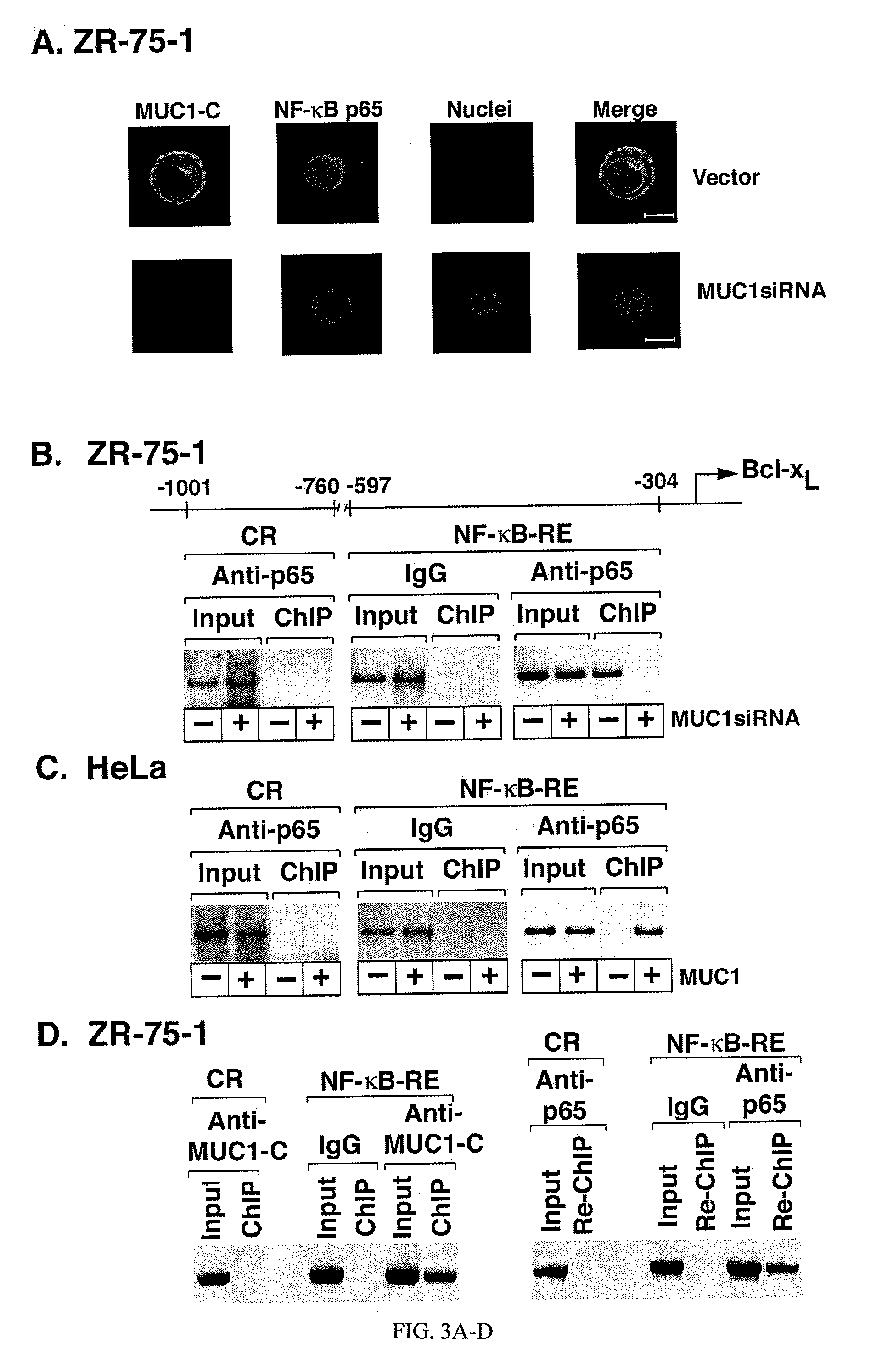Inhibition of inflammation using antagonists of muc1
a technology of muc1 and antagonists, which is applied in the direction of peptides/protein ingredients, drug compositions, peptides, etc., can solve the problems of muc1 antagonist reports, and achieve the effect of inhibiting muc1 competition
- Summary
- Abstract
- Description
- Claims
- Application Information
AI Technical Summary
Benefits of technology
Problems solved by technology
Method used
Image
Examples
example 1
Materials and Methods
[0185]Cell culture. Human ZR-75-1 breast cancer and U-937 leukemia cells were grown in RPMI 1640 medium containing 10% heat-inactivated fetal bovine serum (FBS), 100 units / ml penicillin, 100 μg / ml streptomycin and 2 mM L-glutamine. Human HeLa cervical and MCF-7 breast carcinoma cells were grown in Dulbecco's modified Eagle's medium with 10% FBS, antibiotics and L-glutamine. Human MCF-10A breast epithelial cells were grown in mammary epithelial cell growth medium (MEGM; Lonza, Walkersville, Md.) and treated with 20 ng / ml TNFα (BD Biosciences, San Jose, Calif.). Transfection of the MCF-10A cells with siRNA pools (Dharmacon, Lafayette, Colo.) was performed in the presence of Lipofectamine 2000 (Invitrogen, Carlsbad, Calif.). Cells were treated with 5 μM MUC1 / CQC and MUC1 / AQA peptides synthesized by the MIT Biopolymer Laboratory (Cambridge, Mass.).
[0186]Immunoprecipitation and immunoblotting. Lysates from sub-confluent cells were prepared as described (Ren et al., 2...
example 2
Results
[0191]MUC1-C associates with NF-κB p65. To determine whether MUC1 interacts with NF-κB, anti-NF-κB p65 precipitates from ZR-75-1 breast cancer cells were immunoblotted with an antibody against the MUC1-C subunit cytoplasmic domain. The results demonstrate that MUC1-C coprecipitates with NF-κB p65 (FIG. 1A). Similar findings were obtained with lysates from MCF-7 breast cancer cells, which also overexpress endogenous MUC1 (FIG. 1B). To determine whether the MUC1-N subunit is necessary for the association, studies were performed on U-937 cells that stably express exogenous MUC1-C and not MUC1-N (Agata et al., 2008). The coprecipitation of NF-κB p65 and MUC1-C in these cells demonstrated that MUC1-N is dispensable for the interaction (FIG. 1C). Incubation of ZR-75-1 cell lysates with GST or a GST fusion protein containing the 72 amino acid MUC1-CD further demonstrated that MUC1-CD associates with NF-κB p65 (FIG. 1D). These findings indicated that the MUC1-C subunit associates con...
example 3
Discussion
[0208]Previous Studies. Overexpression of MUC1 is sufficient for the induction of anchorage-independent growth and tumorigenicity (Li et al., 2003a; Huang et al., 2003; Huang et al., 2005). Notably, however, the MUC1 transforming function is abrogated by mutation of the CQC motif in the cytoplasmic domain to AQA (Leng et al., 2007). MUC1 forms oligomers and the CQC motif is necessary for this oligomerization (Leng et al., 2007). Moreover, oligomer formation is necessary for targeting of the MUC1-C subunit to the nucleus (Leng et al., 2007). The inventors synthesized a MUC1-derived peptide that contains the CQC motif and a poly-Arg cell delivery domain for entry into cells. Initial studies with this MUC1 / CQC peptide showed that it inhibits oligomerization of MUC1-CD in vitro, whereas MUC1 / AQA did not. Significantly and consistent with nuclear targeting of MUC1 being dependent on oligomerization (Leng et al., 2007), uptake of the MUC1 / CQC peptide was associated with down-reg...
PUM
| Property | Measurement | Unit |
|---|---|---|
| molecular weight | aaaaa | aaaaa |
| time | aaaaa | aaaaa |
| length | aaaaa | aaaaa |
Abstract
Description
Claims
Application Information
 Login to View More
Login to View More - R&D
- Intellectual Property
- Life Sciences
- Materials
- Tech Scout
- Unparalleled Data Quality
- Higher Quality Content
- 60% Fewer Hallucinations
Browse by: Latest US Patents, China's latest patents, Technical Efficacy Thesaurus, Application Domain, Technology Topic, Popular Technical Reports.
© 2025 PatSnap. All rights reserved.Legal|Privacy policy|Modern Slavery Act Transparency Statement|Sitemap|About US| Contact US: help@patsnap.com



